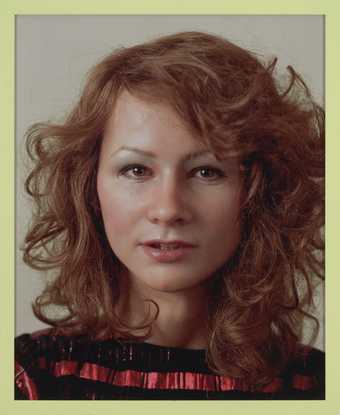
Gillian Wearing CBE
Self Portrait as My Sister Jane Wearing (2003)
Tate
© Gillian Wearing, courtesy Maureen Paley/ Interim Art, London
From changing their own identities to changing the identity of objects, how have artists explored the theme of changed identity?

Gillian Wearing CBE
Self Portrait as My Sister Jane Wearing (2003)
Tate
© Gillian Wearing, courtesy Maureen Paley/ Interim Art, London
What is your identity? How do you see yourself? How do you appear to others?
People can change their identity through the clothes they wear. They can disguise or mask who they are, or take on a different look or character. Trans people often reassign the gender they were assigned at birth in order that their bodies identify with the gender they identify with. They are becoming the person they have always felt they were inside. Moving to another country and having to take on and adapt to a different culture and lifestyle can also impact on personal identity.
National identity is another aspect of identity that changes through history or in response to political events.
As well as people, objects have an identity. This can change depending on how the object is seen and used.
It's important to remember that some artists explore and adopt new identities from a position of privilege, freely exploring new ways of expressing themselves. Others make art because of their often marginalised and unconventional identities.
Do you have what you think of as ‘your look’? Have you ever changed your look? Sometimes just having a different hairstyle, or wearing clothes you do not normally wear can make you feel like a different person.

Georgina Starr
You Stole my Look (1997)
Tate
In You Stole My Look artist Georgina Starr playfully explores the idea that people have a personal look and attach a significance to this look. The print was originally made as a mock advertisement that appears in Starvision, a comic book produced by the artist in 1997. It depicts the Starr in the different outfits she wore when making the comic. The uneven arrangement of images along with its handwritten labels and bright colours, recall teen magazines or perhaps homemade publications or zines.
Artists Gillian Wearing and Cindy Sherman also use portraits and self-portraits to explore identity. But instead of documenting their own look, they take on other people’s looks. By dressing up and posing as other people, they create a changed identity.
Wearing’s photographs explore how the public and private identities of ordinary people are self-made and documented. For her series Album 2003, Wearing reconstructed old family snapshots. In this photograph she wears a dress and hairstyle her sister wore in the 1980s. With the help of experts at Madame Tussauds she also fabricated a silicone masks of her sister’s face. By putting a version of someone else’s face on hers she is metaphorically ‘seizing’ their identity. The only bits of Wearing that can be seen are her eyes and teeth.
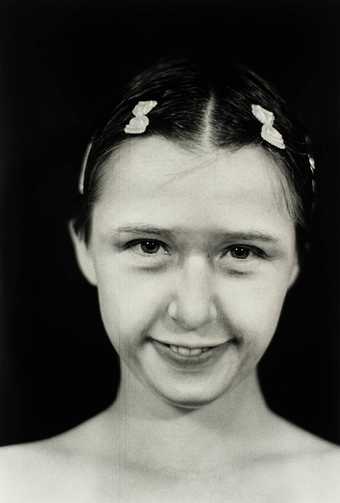
Cindy Sherman
Untitled D (1975)
Tate

Cindy Sherman
Untitled Film Still #17 (1978, reprinted 1998)
Tate
Transforming herself into other people is central to Cindy Sherman’s work.
In college I began to collect a lot of discarded accoutrements from the 1940s, 1950s and 1960s, more for my own personal wardrobe as well as for the sheer fascination with what those garments stood for. It was easy and cheap to collect all kinds of things in those days. I’ve always played with make-up to transform myself …
Cindy Sherman
Untitled D is from a series of photographs where Sherman radically alters her appearance using make-up, hairstyles, hats and different facial expressions. She has explained, ‘I made [them] to show the process of turning one character into another'.
Cindy Sherman's Bus Riders 1976/2000 are a series of photographs that feature the artist as a variety of closely observed characters. Sherman uses elaborate costumes and make up to transform her identity for each image.
By changing their appearance, artists Gillian wearing and Cindy Sherman put on a type of mask. Their hair, makeup and clothes masked their appearance.
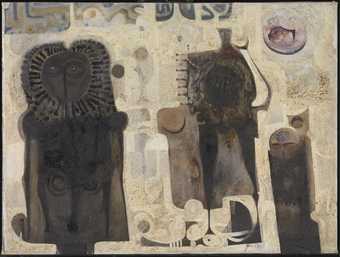
Ibrahim El-Salahi
They Always Appear (1964)
Tate
Masks have been used for thousands of years to hide or transform a person’s appearance. In Ancient Greek theatre masks were worn to effectively change the character of the actor. In African ritual, masks are worn to replace the identity of the wearer with a spiritual being. Sudanese artist Ibrahim El-Salahi includes African masks alongside Arabic calligraphy in his painting such as They Always Appear 1964. In combining these motifs he suggest the dual cultural influences within his country.
Cindy Sherman, along with other artists, has also used her changed appearance to comment on wider issues in society.

Cindy Sherman
Untitled Film Still #17 (1978, reprinted 1998)
Tate
In Untitled Film Stills Sherman photographs herself as fictitious female characters in scenes that look like moments in a film. She masquerades in conventional female cinema roles such as the lover or the young housewife. By doing this she draws attention to the way that Hollywood cinema has contributed to stereotypes about women.
Nigerian photographer Samuel Fosso also documents himself adopting a range of different personas to explore stereotypes. Transforming his identity using clothing, props and posture he presents himself as a range of ‘male types’ from macho to sensitive and vulnerable.

VALIE EXPORT
Identity Transfer 1 (1968, printed late 1990s)
Tate
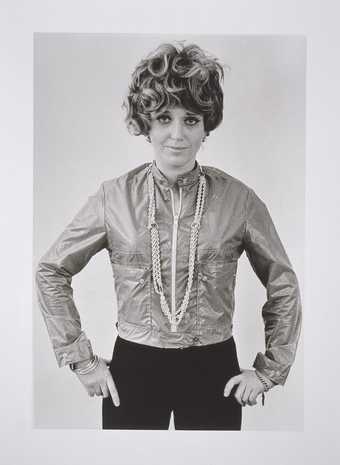
VALIE EXPORT
Identity Transfer 2 (1968, printed late 1990s)
Tate
Austrian artist VALIE EXPORT explores the limits imposed on the individual based on their gender. For her Identity Transfer photographs she stands with her legs slightly apart and her hands on her hips looking confidently at the camera. The pose is very different from the way women are normally photographed in the media and contrasts with her hairstyle and make-up. In these works she is playing with the codes through which gender identity is traditionally conveyed.
Scottish artist Rachel Maclean also changed her identity to comment on society. In her video works she parodies social media, beauty-product advertising, children’s television and pop culture. At once seductive and nightmarish, glossy and grotesque, her films criticise our dependence on technology and obsession with shopping. Maclean plays all the parts herself, changing her identity by wearing extravagant costumes and make-up.
Watch a clip from Rachel Maclean’s film Its What’s Inside that Counts and see society like you’ve never seen it before!
This film file is broken and is being removed. Sorry for any inconvenience this causes.
Rachel Maclean It’s What’s Inside That Counts 2016, film extract. Courtesy of Rachel Maclean © Rachel Maclean
VALIE EXPORT, Cindy Sherman and Samuel Fosso transformed their identities in self-portraits to investigate gender roles and stereotypes. Other artists have used portraiture and self-portraiture to explore more personal aspects of gender.
Grayson Perry decorates his ceramic vases and pots with illustrations that address issues of identity, class, sexuality and gender. Perry often dresses as a woman, changing his identity from Grayson Perry into ‘Claire’ his female alter ego. In Aspects of Myself he depicts himself as Claire.
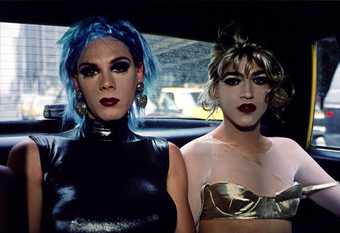
Nan Goldin
Misty and Jimmy Paulette in a taxi, NYC (1991)
Tate
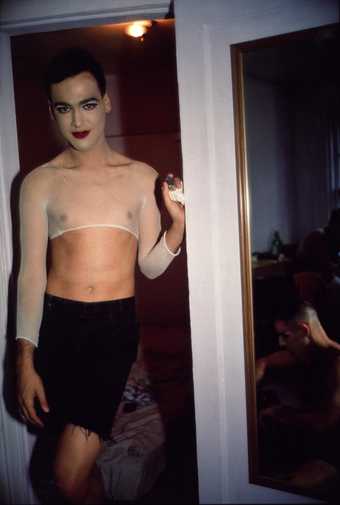
Nan Goldin
Jimmy Paulette and Tabboo! undressing, NYC (1991)
Tate
Nan Goldin’s powerful photographs document the lives of her friends. She created a series of intimate portraits of her drag-queen and friends working in drag-performance .
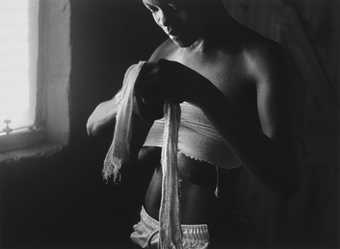
Zanele Muholi
ID Crisis (2003)
Tate
In her photographs Zanele Muholi focuses on the difficulties lesbians and transgender people face in Africa. She also sees her work as challenging the way the black female body has been presented historically in art. ID Crisis 2003 shows a young woman standing in a gloomy room carefully wrapping bandages around her breasts in an attempt to disguise her anatomy, as light streams in from an adjacent window.
Your personal identity – who you are – is affected by lots of things. Where you were born and grew up and the culture of that place has a huge impact on your identity. What happens if you move to a different place and culture? As well as exploring identity in relation to gender, art can be a powerful tool for exploring how identity changes when you move from one culture to another.
Artist Njideka Akunyili Crosby was born in Nigeria and lived there until she was sixteen. In 1999 she moved to the United States. Her cultural identity combines strong attachments to the country of her birth and to her adopted home. In her layered compositions she explores this changed hybrid identity.
Like Njideka Akunyili Crosby, Sonia Boyce uses layers of imagery and ideas to explore her sense of self. Boyce is a black British artist. In From Tarzan to Rambo … she looks at the images and roles of black people as presented in predominantly white-controlled film and media. These impose a whole other identity on her sense of self. The work explores the complex interweaving of black history with classic Hollywood narratives and other mass cultural forms.
Zineb Sedira lives in London but was born in Paris. Her parents are Algerian. Mother Tongue 2002 explores migration and her family's cultural identity. In the video her daughter, born in Britain and speaking English, tries to communicate with her Algerian grandmother, who speaks Arabic. Grandmother and daughter are reliant on Sedira, who speaks Arabic, French and English, to communicate.

Zineb Sedira
Mother Tongue (2002)
Tate
Artist Yinka Shonibare describes himself as ‘a postcolonial hybrid’. He was born in London and grew up in the UK and Nigeria.
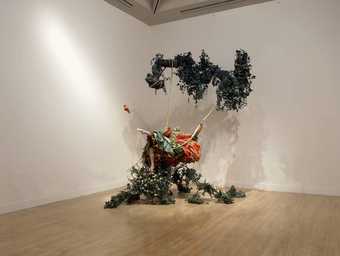
Yinka Shonibare CBE
The Swing (after Fragonard) (2001)
Tate
© Yinka Shonibare, courtesy Stephen Friedman Gallery, London
The African fabrics he uses have a complex history. The batik printing technique used to make them was originally Indonesian. It was then appropriated by the Dutch during the colonial period. English manufacturers later copied the Dutch production model using designs derived from traditional African textiles. The fabrics were manufactured in Manchester using a predominantly Asian workforce. They were then exported to West Africa. The fabrics became popular during the African independence movement. Their bright colours and geometric patterns were associated with the struggle for political and cultural independence.
So far in this exam help resource we have explored various aspects of personal identity and how these can change. National identity is another type of identity. This is how a nation sees itself and how it is seen by others. History, culture, characteristics and values can all affect national identity.

Jason Evans, stylist Simon Foxton
Untitled (from the Strictly Series) (1991)
Tate
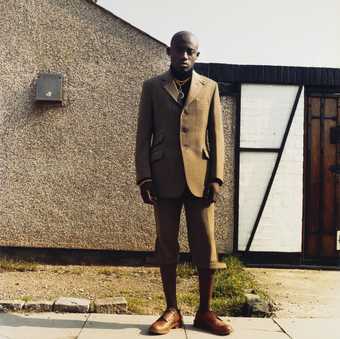
Jason Evans, stylist Simon Foxton
Untitled (from the Strictly Series) (1991)
Tate
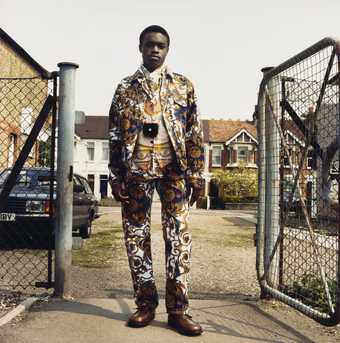
Jason Evans, stylist Simon Foxton
Untitled (from the Strictly Series) (1991)
Tate
Jason Evans used the idea of different identities to explore national identity. Strictly is a series of portrait photographs showing young black men dressed in the clothing generally associated with English country gentlemen. The photographs were made in collaboration with fashion stylist Simon Foxton. Evans and Foxton were inspired by the diverse street style worn by people of colour in Britain and decided to turn the traditional idea of British identity on its head.
Strictly was a weird mixture of macho clothes and quite effeminate clothes. Sportswear-based but classical English things, turned around. The syntax of clothes was completely upside down, and then, worn by black people, it was a new vision of Britain. We were trying to break down stereotypes.
Jason Evans
Palm Sign is a large painted metal sculpture of a palm tree, illuminated with coloured light bulbs. It has the run-down look of a decaying beach sign in a tired holiday resort.
The work symbolises Moroccan artist Yto Barrada’s concerns about the changing identity of her country. Palm trees are often used in marketing campaigns to promote Morocco as a holiday destination. Yto Barrada uses this decaying palm tree to represent her fears about the rapid development of Morocco as a tourist destination. She worries about what huge hotel complexes and golfing resorts will do the fragile eco-system of the country.
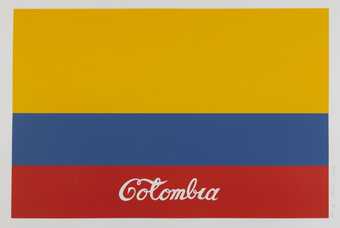
Antonio Caro
Colombia (1977)
Tate
Antonio Caro changes the Colombian national flag to comment on what he saw as the altered identity of his country. He has added the name of the country to the flag using the calligraphy of the Coca-Cola logo. With this graphic play, he criticises the intrusion of American commercialism and how this has affected his country.
Changing identity as a theme in art can also be explored in relation to objects. All art processes involve changing one thing into another. Gooey paint becomes a picture, a block of wood or stone is transformed into a carved sculpture. Artists who use found objects to make art, are changing something that already has an identity into something else. A functional object becomes an artwork. Marcel Duchamp turned a urinal upside down and called it Fountain. He radically changed the identity of a piece of plumbing into an iconic and much discussed masterpiece.
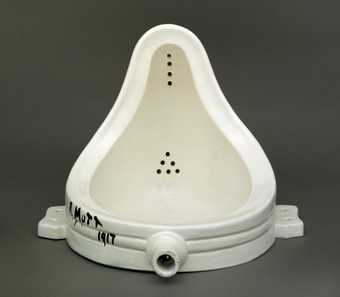
Marcel Duchamp
Fountain (1917, replica 1964)
Tate
© Succession Marcel Duchamp/ADAGP, Paris and DACS, London 2025
Surrealist artists often used found objects in their artworks and changed their identity by showing them in unexpected ways. Their aim was to encourage the viewer to reject a rational vision of life and tap into unconscious thoughts and dreams. Man Ray effectively altered the identity of this object by simply wrapping it in a blanket. Can you tell what it is?

Man Ray
L’Enigme d’Isidore Ducasse (1920, remade 1972)
Tate
Artists such as Lubaina Himid and Theaster Gates make use of the past history of found objects to add meaning to their work. By using them to convey a message or meaning they altered these objects’ identities.
What I really like to do is to use a whole series of found objects with a given history if you like and then paint a history on them that isn’t as much talked about.
Lubaina Himid
Himid incorporates found objects into her work, often combining them with painted cutout figures. Her paintings and installations explore ideas around black British representation and identity. In this video she discusses her ideas and processes including the use of found objects in her work.
Civil Tapestry 4 looks like an abstract painting. But it is actually made from recycled fire hoses. The work refers to a shocking event that took place in Alabama in May 1963. A group of black school children and students were marching peacefully for equal rights in Birmingham, Alabama. Police used powerful fire hoses to break up the march, injuring many of the young protestors.
The police brutality was widely condemned. These events were seen as a pivotal moment in the Civil Rights Movement. Gates commented:
The event led to immediate shifts in the American South and created opportunity for black people to integrate.
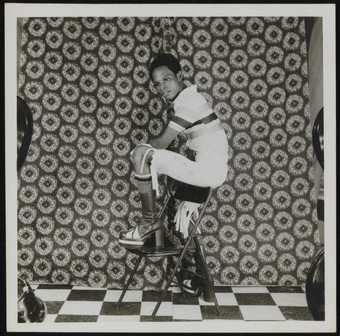
Samuel Fosso
Untitled (1978)
Tate
Cindy Sherman, Gillian Wearing, Samuel Fosso and Rachel Maclean all used themselves to explore the theme of changed identity. They used clothing, make up, props and poses they altered their appearance. Cindy Sherman and Samuel Fosso used self-portraits to explore the idea of stereotypes. Rachel Maclean comments on social media, technology and consumerism.
By using found objects to make artworks, artists change the identity of those objects. The Surrealists changed the identity of objects by showing them in unexpected ways. Have a go at changing the identity of an object to create a surrealist sculpture or painting:
Artists such as Theaster Gates and Lubaina Himid use found objects with a history to add resonance to their work and help convey a message.
Are there any objects that remind you of a particular event or person? For example you might remember the shoes you wore on your first day of school. Or have a piece of jewelry or an ornament your granny gave you. Or you might have saved an image or article about a national or international event that affected or moved you.